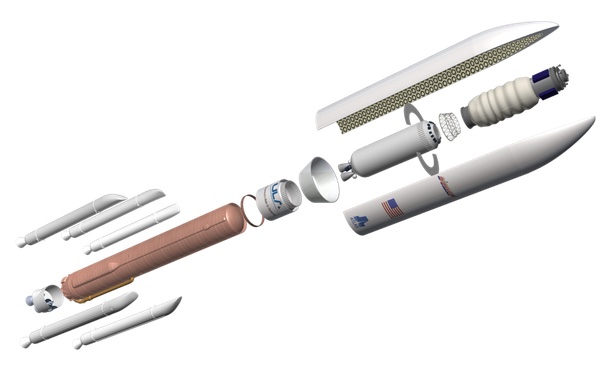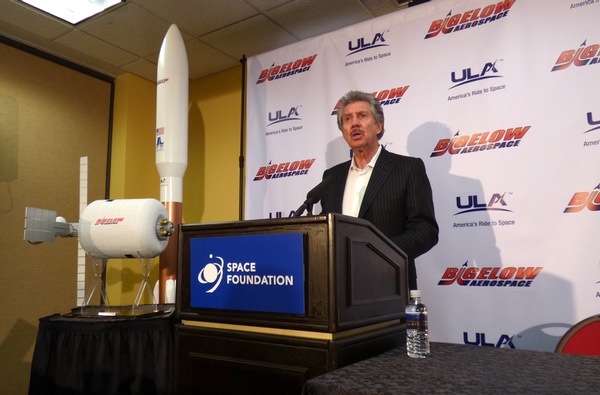Next to the launch itself, and the successful landing of the Falcon 9 first stage at sea (see “Closing the case for reusable launchers”, The Space Review, April 11, 2016), the most popular aspect on the recent Dragon cargo mission to the International Space Station was its largest. The Bigelow Expandable Activity Module (BEAM), stored inside the unpressurized trunk section of the Dragon, was the latest effort by Las Vegas-based Bigelow Aerospace to demonstrate the company’s core technology of expandable habitat modules.
| “Inflatables make you think of things like balloons that don’t have a structure in and of themselves,” explained NASA’s Crusan on why they prefer the term “expandable”. |
And NASA has gone to great pains to emphasize that “expand” is preferred over “inflate.” “Inflatables make you think of things like balloons that don’t have a structure in and of themselves,” explained Jason Crusan, director of NASA’s Advanced Exploration Systems division, at a pre-launch press conference April 7 at NASA’s Kennedy Space Center. An expandable structure, by contrast, has its own structure holding it together, like a tent. “The rigidity of the device means that, if something were to happen, it still maintains its physical structure.”
Whatever you call it, BEAM is designed to be a testbed for future, more ambitious, expandable modules. It will, at least initially, remain sealed off from the rest of the station, with astronauts only infrequently entering the module to check on instruments monitoring its environment.
At that pre-launch press conference, though, the president of Bigelow Aerospace suggested BEAM could later be used for commercial applications as well. “We have, actually, four different groups today that want to fly experiments and different payloads to BEAM, and deploy those within BEAM,” Robert Bigelow said. Two of the groups represent countries and the other two corporations, although he did not specifically name any of them. “We’re hoping that, maybe in half a year or something, we can get permission from NASA to accommodate these people in some way.”
BEAM, then, may be not just a technical precursor to larger expandable modules, but a commercial one as well. On Monday, just three days after the launch of BEAM, Bigelow Aerospace and United Launch Alliance announced a partnership where the two companies will work together, an effort that could eventually lead to the launch of larger Bigelow modules on ULA’s Atlas 5.
Bigelow, at the pre-launch press conference, dropped hints that Bigelow would work with ULA. He noted that the only vehicle available now to launch Bigelow’s B330 habitat—a module with 330 cubic meters of volume once expanded—is the Atlas V 552. (That vehicle, strictly speaking, doesn’t exist yet: the dual-engine Centaur upper stage, indicated by the “2” in its designation, has yet to fly on an Atlas but is under development.) “We have to fit into two things: a vehicle that can lift 43,000 pounds [19,500 kilograms], and a vehicle that has a fairing length” long enough to accommodate the B330 in its compressed form, he said.

An illustration of the B330 module (top right) accommodated within an Atlas V 552. (credit: ULA/Bigelow Aerospace)
|
“We’re trying to acquire permission from NASA to be able to locate a B330 on station,” Bigelow said. “If we’re able to do that, and have that space be there, we’re also asking permission to be able to commercialize time and volume” on the module once installed.
| “Our hope is that NASA would be the primary customer for that structure, and that we would be given permission to commercialize. Essentially, we would be timesharing,” said Bigelow. |
“If it can be achieved on station,” Bigelow said of installing the B330 there, “NASA maximizes the utility of its staff that is already on station. It may also be a facility that partners are going to get excited about. We think this will add life beyond 2024 to the ISS, and there are a lot of folks who do not want to see the ISS go into the drink.”
And, as Bigelow has proposed for BEAM, a B330 on the station could be used for commercial, as well as NASA, applications. “Our hope is that NASA would be the primary customer for that structure, and that we would be given permission to commercialize. Essentially, we would be timesharing. So, what we’re going is we’re offering discrete quantities of time—a matter of one or two weeks, to 45 days—to various kinds of clientele,” he said.
All that requires extensive discussions with NASA, and the station’s other international partners, about both technical and business issues regarding a B330 on the station. “We’ve had several discussions” with the space agency, Bigelow said after the press conference. “It’s a process.”
“They have to consider the partners, the station partners,” Bigelow said of NASA. “We experienced this with BEAM. We had to recognize that that location is about the most sensitive location in space that there is. Even with BEAM we had to be concerned with perturbations to the entire structure on its expansion.”
Getting B330 onto station involves a “gauntlet of challenges,” he acknowledged, that the company would not have to go through if the module was a free flyer. So, why go through the hassle of installing the module on the ISS when it would be easier, from both a technical and business development standpoint, to go it alone?

Bigelow
Aerospace president Robert Bigelow discussing his plans to include a
B330 module on the ISS during an April 11 press conference at the 32nd
Space Symposium in Colorado Springs. (credit: J. Foust)
|
While not explicitly stated, working with NASA on adding a B330 to the ISS would involve some kind of contract or funded agreement. That could, presumably, help finance the development of the B330.
Bigelow hasn’t abandoned the idea of free-flyer stations. The company plans to have two B330 modules ready for launch in 2020, and expects to produce more in the years to come. The number of B330 modules the company builds and launches will depend in large part on the company’s ability to expand its workforce to accommodate projected demand, he said.
“I think we could expect possibly to populate several different destinations in addition to the ISS” by the mid-2020s, Bigelow said.
All of this, though, is still in its early development phases. The partnership announced last week does not involve a launch contract or other formal agreement between ULA and Bigelow Aerospace, for example. “This is a work in progress,” Bigelow said. “We do have an agreement on something that would be typical when you are doing the really early, preliminary work in terms of characterization of a payload.”
| “This is a fundamentally new mission in space. We haven’t had one of those in probably 20 or 30 years, arguably,” said Bruno. |
Bruno expressed his excitement, though, about the partnership in general and the potential of Bigelow Aerospace to establish new markets in space. “This is a fundamentally new mission in space. We haven’t had one of those in probably 20 or 30 years, arguably,” he said. “So this is creating new things to do in space, making the space economy larger. That in of itself is an exciting goal.”
It won’t be easy, though, as Bigelow made clear near the end of the press conference. “I think there are a lot of challenges here, and when you’re trying to do something really novel, that isn’t simple, the odds are huge it’s going to be a struggle,” he said. “This is not going to be any kind of a simple situation.”
“But,” he added, “there are a number of commonalities here in terms of benefits that the logic really says this is something that ought to be done.”
No comments:
Post a Comment